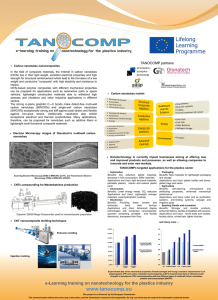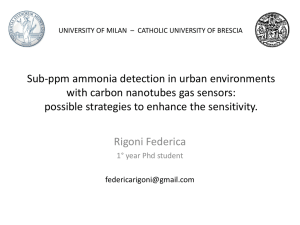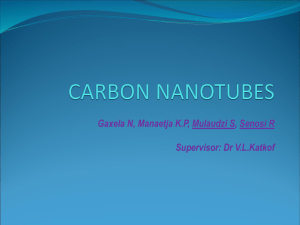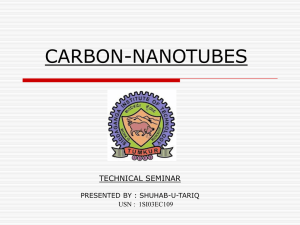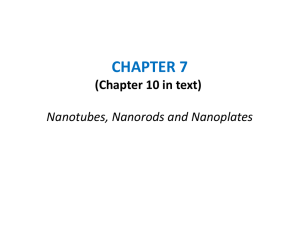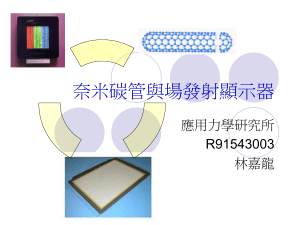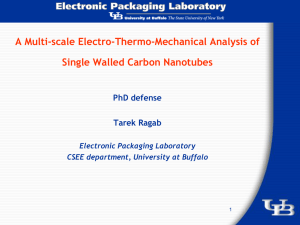Nanotechnology Lecture 3 Carbon Nanotubes
advertisement
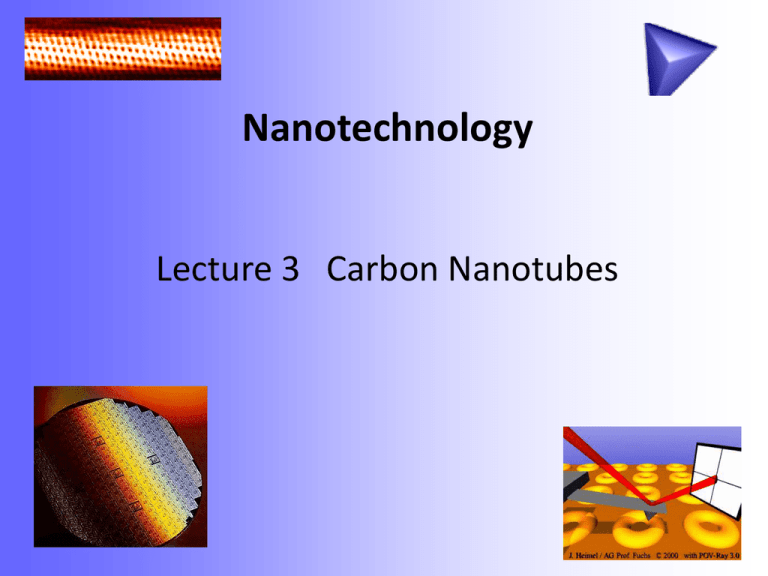
Nanotechnology Lecture 3 Carbon Nanotubes Carbon nanotubes •Introduction of Carbon Nanotubes •History and Impacts •Structure of Carbon Nanotubes (SWNT MWNT) •Properties of Carbon Nanotubes •Synthesis of Carbon Nanotubes (fabrication) •Potential and current Applications What is Carbon Nanotube? Introduction of Carbon Nanotube • Allotropes of carbon (graphite , diamond , Amorphous carbon and Fullerene ) (cylindrical members of the fullerene structural family) • with a nanostructure. length-to-diameter ratio of up to 132,000,000:1,which is significantly larger than any other material. • extraordinary strength and unique electrical properties, efficient thermal conductors. (limited by their potential toxicity) • amazing objects? creates by accident, without meaning to, but that will likely revolutionize the technological landscape of the century ahead. • Our society stands to be significantly influenced by carbon nanotubes, shaped by nanotube applications in every aspect, just as silicon-based technology still shapes society today. History and Impacts • Carbon nanotubes have been synthesized for a long time as products from the action of a catalyst over the gaseous species originating from the thermal decomposition of Hydrocarbons. • The worldwide enthusiasm came unexpectedly in 1991, after the catalyst-free formation of nearly perfect concentric multiwall carbon nanotubes (c-MWNTs) was reported as by-products of the formation of fullerenes by the electric-arc technique. • Consequently, about five papers a day with carbon nanotubes as the main topic are currently published by research teams from around the world, an illustration of how extraordinarily active – and highly competitive – is this field of research. • Economical aspects are leading the game to a greater and greater extent. According to experts, the world market is predicted to be more than 430M$ in 2004 and estimated to grow to several b $ before 2009. Structure of Carbon Nanotubes • Carbon nanotubes are fullerene-related structures which consist of graphene cylinders closed at either end with caps containing pentagonal rings(五角环). Discovered in 1991 by the Japanese electron microscopist Sumio Iijima. Nanotubes could be produced in bulk quantities by varying the arcevaporation conditions. Tetrahedral Junction of four Nanotubes Nanotube w/ hemispheric Structure of Carbon Nanotubes Single-Wall Nanotubes SWNTs The (n,m) nanotube naming scheme can be thought of as a vector (Ch) in an infinite graphene sheet that describes how to "roll up" the graphene sheet to make the nanotube. T denotes the tube axis, and a1 and a2 are the unit vectors of graphene in real space. Most single-walled nanotubes (SWNT) have a diameter of close to 1 nanometer, with a tube length that can be many millions of times longer. The structure of a SWNT can be conceptualized by wrapping a one-atom-thick layer of graphite called graphene into a seamless cylinder. The way the graphene sheet is wrapped is represented by a pair of indices (n,m) called the chiral vector. The integers n and m denote the number of unit vectors along two directions in the honeycomb crystal lattice of graphene. If m = 0, the nanotubes are called "zigzag". If n = m, the nanotubes are called "armchair". Otherwise, they are called "chiral". Single-Wall Nanotubes SWNTs Armchair (n,n) Zigzag (n,0) The chiral vector is bent, while the translation vector stays straight Chiral (n,m) Graphene nanoribbon n and m can be counted at the end of the tube The chiral vector is bent, while the translation vector stays straight Graphene nanoribbon Single-Wall Nanotubes SWNTs (n,0) zigzag nanotube (9, 0) (n,n) armchair nanotube (5, 5) (n,m) helical (chiral) nanotube (10,5) - hexagonal rings, pentagonal rings at each tips; - C=C bond and C≡C bond, ( n and m are the integers of the vector OA consideringinducing a unique versatile electronic behavior. the unit vectors a1 and a2. ) Single-Wall Nanotubes SWNTs Fig. 3.3 Image of two neighboring chiral SWNTs within a SWNT bundle as seen by high resolution scanning tunneling microscopy (by courtesy of Prof. Yazdani, University of Illinois at Urbana, USA) SWNT Rope Multiwall Nanotubes MWNT •Multi-walled nanotubes (MWNT) consist of multiple rolled layers (concentric tubes) of graphite; •In the Russian Doll , sheets of graphite are arranged in concentric cylinders; •In the Parchment model, a single sheet of graphite is rolled in around itself, resembling a scroll of parchment or a rolled newspaper. (3.3 Å); Fig. 3.5 (longitudinal view) of a concentric multiwall carbon nanotube (c-MWNT) prepared by electric arc. In insert, sketch of the Russian-doll-like display of graphenes Multiwall Nanotubes MWNT (a) as-grown. The nanotube surface is made of free graphene edges. (b) after 2,900 ◦C heat- treatment. Both the herringbone and the bamboo textures have become obvious. Fig. 3.6a,b A herringbone(箭尾型) (and bamboo) multi-wall nanotube (bh-MWNT, longitudinal view) prepared by CO disproportionation on Fe-Co catalyst. Fig. 3.7 (a) A bamboo-herringbone multi-wall nanotube (bh-MWNT) showing the nearly periodic feature of the texture,which is very frequent; (b) high resolution image of a bamboo-concentric multiwall nanotube (bc-MWNT) . They are sometimes referred as “nanofibers”. Nanobud •carbon nanotubes + fullerenes. •useful properties of both fullerenes and carbon nanotubes. •In particular, they have been found to be exceptionally good field emitters. • In composite materials, the attached fullerene molecules may function as molecular anchors preventing slipping of the nanotubes, thus improving the composite’s mechanical properties Extreme carbon nanotubes •The longest carbon nanotubes (18.5 cm long) was reported in 2009. These nanotubes were grown on Si substrates using an improved chemical vapor deposition (CVD) method and represent electrically uniform arrays of singlewalled carbon nanotubes •The thinnest carbon nanotube is armchair (2,2) CNT with a diameter of 3 Å •The thinnest free standing single-walled carbon nanotube is about 4.3 Å in diameter. Researchers suggested that it can be either (5,1) or (4,2) SWCNT, but exact type of carbon nanotube remains questionable. Properties of Carbon Nanotube Strength •the strongest and stiffest materials . •In 2000, a MWCN was tested to have a tensile strength of 63 gigapascals (the ability to endure tension of 6300 kg on a cable with cross-section of 1 mm2.) •low density for a solid of 1.3 to 1.4 g·cm−3 •Standard single walled carbon nanotubes can withstand a pressure up to 24GPa without deformation (hardness) Kinetic Multi-walled nanotubes, multiple concentric nanotubes precisely nested within one another, exhibit a striking telescoping property whereby an inner nanotube core may slide, almost without friction, within its outer nanotube shell thus creating an atomically perfect linear or rotational bearing. Electrical moderate semiconductor. Synthesis of Carbon Nanotube 1 Laser Ablation – Experimental Devices - graphite pellet containing the catalyst put in an inert gas filled quartz tube; -oven maintained at a temperature of 1,200 ◦C; -energy of the laser beam focused on the pellet; -vaporize and sublime the graphite Sketch of an early laser vaporization apparatus The carbon species are there after deposited as soot in different regions: water-cooled copper collector, quartz tube walls. 2 Synthesis with CO2 laser Vaporization of a target at a fixed temperature by a continuous CO2 laser beam (λ = 10.6μm). The power can be varied from 100Wto 1,600 W. The synthesis yield is controlled by three parameters: the cooling rate of the medium where the active, secondary catalyst particles are formed, the residence time, and the temperature (in the 1,000– 2,100K range) at which SWNTs nucleate and grow. Fig. 3.10 Sketch of a synthesis reactor with a continuous CO2 laser device 3 Electric-Arc Method – Experimental Devices After the triggering of the arc between two electrodes, a plasma is formed consisting of the mixture of carbon vapor, the rare inert gas (helium or argon), and the vapors of catalysts. The vaporization is the consequence of the energy transfer from the arc to the anode made of graphite doped with catalysts. Sketch of an electric arc reactor. It consists of a cylinder of about 30 cm in diameter and about 1m in height. Electric-Arc Method – Experimental Devices • In view of the numerous results obtained with this electric-arc technique, it appears clearly that both the nanotube morphology and the nanotube production efficiency strongly depend on • the experimental conditions and, in particular, • on the nature of the catalysts. 4 Solar energy reactor Sketch of a solar energy reactor in use in Odeilho (France). (a) Gathering of sun rays, focused in F; (b) Example of Pyrex® chamber placed in (a) so that the graphite crucible is at the point F. The high temperature of about 4,000K permits both the carbon and the catalysts to vaporize. The vapors are then dragged by the neutral gas and condense onto the cold walls of the thermal screen. Application: Nanotube-based SPM (scanning probe microscopy) tips Fig. 3.27 Scanning electron microscopy image of a carbon nanotube (MWNT) mounted onto a regular ceramic tip as a probe for atomic force microscopy. Small diameters of SWNTs were supposed to bring higher resolution than MWNTs due to the extremely short radius of curvature of the tube end. But commercial nanotubebased tips use MWNTs for processing convenience. Application: Efficient Field Emitters The electrons are taking out from the tips and sent onto an electron sensitive screen layer. Replacing the glass support and protection of the screen by some polymer-based material will even allow the develop of flexible screens. Fig. 3.28 (a) Principle of a field-emitter- based screen. (b) SEM image of a nanotube-based emitter system (top view). Round dots are MWNT tips seen through the holes corresponding to the extraction grid. The first commercial flat TV sets and computers using nanotube-based screens are about to be seen in stores. (Motorola, NEC, NKK, Samsung, Thales, Toshiba, etc.) Application: Chemical Sensors (a) Increase in a single SWNT conductance when 20 ppm of NO2 are added to an argon gas flow. (b) Same with 1% NH3 added to the argon gas flow Fig. 3.29a,b Demonstration of the ability of SWNTs in detecting molecule traces in inert gases. Fig. 3.30 Transmission electron microscopy image showing rhodium铑 nanoparticles supported on MWNT surface


